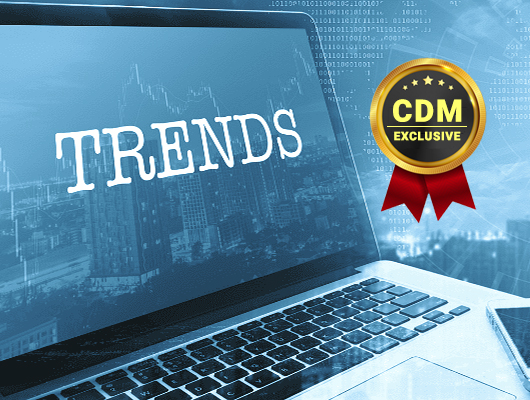By Tej Redkar, Chief Product Officer at LogicMonitor
If 2020 has taught us anything, it is that life is nothing if not unpredictable. Yet, the unforeseen possibilities of tomorrow are the very reasons why our society has fully embraced technology today. In the past decade, technology trends such as artificial intelligence (AI) and automation have improved us as a society by fostering faster collaboration and saving us a significant amount of time. At the forefront of modern-day trends is AIOps, or the practice of using AI in IT Operations (ITOps).
AIOps platforms combine big data and machine learning to find patterns, identify problems, and predict and prevent future issues from occurring. More recently, AIOps has been a valuable tool in helping companies scale high volumes of data due to the unprecedented shift to a remote workforce. As AIOps continues to grow in popularity, it’s important to keep up with key trends in its progression. The following reflects a variety of trends that I have my eye on for next year.
- AIOps Is Moving from One Data Type to Multiple Data Type Algorithms
AIOps traditionally uses big data platforms to aggregate siloed IT Operations data in one place. Looking ahead, data scientists will be designing AI algorithms to converge multiple data types, such as metrics, logs, and transactions, to draw a correlation and identify differences in the combined data. The trend emerged after various probabilistic methods, such as AI, machine learning, and statistical analysis were applied to metrics, logs and transactions. These actions allowed data scientists to draw a correlation between the data sets and filter out the signal from noise so that organizations can troubleshoot issues faster.
When it comes to investing in AIOps, the ultimate goal is to save people time — either through early warnings, filtering signal from noise, or automation — so they can focus on more important problems rather than doing repetitive routine work. Many technology companies have already started investing in that trend.
- Remote Work Is Driving More Technology Platforms to Deploy AI To Detecting Problems
Remote work will be the legacy of 2020 and likely the new status quo moving forward. Prior to the coronavirus pandemic, data was typically concentrated in very specific areas due to collective working environments. Now that the pandemic has forced companies to support a remote workforce, every individual remote user is a data generator — causing data volumes to skyrocket.
Monitoring employee productivity and digital continuity is crucial during these times, yet remains challenging for ITOps teams to manage. More intelligent algorithms are needed to predict issues with employee productivity or customer experience using the product remotely. This is where AI helps.
When it comes to AI, it doesn’t matter where users are working from. Once an algorithm is programmed, its only job is to ingest the data, extract intelligence, and then output the optimized value. The AI function can automate complex processing of disparate data sources and help IT teams predict problems before they occur by detecting patterns in large volumes of data.
- AIOps will become more embedded in observability platforms
AIOps and observability will soon become counterparts to empower ITOps to do more in less time. Observability in IT refers to a system’s ability to gather actionable data and diagnose what’s happening, where it’s happening, and — more importantly — why an error or issue occurred within the system. This is done by combining monitoring, log analysis, and machine learning into an environment that can easily detect issues, proactively identify anomalies, and scale as necessary.
Observability platforms examine metrics, dependencies and logs, and bring them together into a unified platform to detect patterns between the different data types. This data provides greater observability into the customer experience, employee productivity, as well as digital infrastructure to help teams better understand how the business is performing.
After achieving observability, ITOps teams must answer the question of what to do with this information. That’s where AIOps comes in. By taking an algorithmic approach to ITOps combined with machine learning, IT teams can automate an influx of data to output actionable insights faster than ever before. AIOps platforms also enable their users to set dynamic thresholds, identify anomalies, and find the root cause of an issue. By embedding AIOps and observability into one unified platform, IT teams can predict problems faster and resolve them before it negatively impacts the business.
- Security and IT Operations Will Be Better Integrated
As enterprise IT environments continue to mature, the need for advanced security platforms will inevitably follow. The fundamental data sets used in security platforms, including cybersecurity and product security, are almost the same as IT operation data sets. Security algorithms dissect metrics and logs that flow through infrastructures to model historical behavioral patterns and flag anomalies. Using AI, this process can be further automated towards blocking bad actors in real-time.
For example, say a hacker is trying to penetrate a firewall that is detected by either a change in the volume of data or a change in the location of the traditional user. Security features can be used to classify that particular access as either regular access, hacker access, or insecure access. Once the access data is detected, automation systems can block the IP address of the hacker’s particular region or that particular range.
Regardless of the business problem, the underlying data required to gather this intelligence is still logs, metrics, and transactions within an infrastructure. The only difference is the problem that IT security teams are trying to solve. Security teams want to know whether a bad actor is trying to access the system, while ITOps teams are more interested in employing applications that will protect their users and provide a better customer experience. Next year, ITOps and Security teams will likely collaborate more closely to not only detect problems in the infrastructure performance but also prevent cybersecurity threats in near real-time.
- AIOps Platforms Will Decrease Time-to-Value
While AIOps platforms are meant to handle added complexity, humans are still required to configure and deploy them. Next year, AIOps capabilities will become more mainstream within products. SaaS products, in particular, will improve significantly with better actionable insights and new proactive capabilities within the product. This advancement will set the foundation for future integrated self-healing systems, which will further reduce the burden on human teams.
Properly educating employees on AIOps platforms also affects time-to-value. AIOps platforms are most efficient when they are managed by the right team. Investing in AIOps just to say you have it doesn’t add value to the business if IT isn’t sure how to use AIOps. Build a team that is cross-functional between the business, data owners, and engineers. Together, these three pillars will be able to derive real value out of any AIOps initiative.
I constantly see organizations driving initiatives tied to buzzwords instead of a real business problem. AIOps is about solving complex business problems, and, therefore, IT teams should identify the problems they want to overcome before diving in headfirst. Once that is understood across the board, solving problems using AI becomes easier. If organizations do not follow this basic advice, they will likely remain in a state of AI immaturity and will spend significant amounts of time on failed projects.
The Bottom Line
AIOps is a journey, not a quarterly goal or a yearly goal. From a business perspective, AIOps should be invested in for the long-term, but only after knowing where the business stands within its own maturity journey.
About the Author
 Tej Redkar has been building enterprise software products for more than 20 years. He has led engineering, product management, user experience, and data science teams in industry-leading organizations like Microsoft, VMWare, Cisco, and AppDynamics. Tej has consistently delivered highly successful products like Rational Rose, VMware Labs, Microsoft Azure Machine Learning, PowerBI, and AppDynamics that have fundamentally transformed people’s productivity in their respective domains. As Chief Product Officer, Tej brings the right balance of business and deep technical expertise to the team to drive strategy and execution at LogicMonitor. You can learn more about Tej Redkar and LogicMonitor at www.logicmonitor.com.
Tej Redkar has been building enterprise software products for more than 20 years. He has led engineering, product management, user experience, and data science teams in industry-leading organizations like Microsoft, VMWare, Cisco, and AppDynamics. Tej has consistently delivered highly successful products like Rational Rose, VMware Labs, Microsoft Azure Machine Learning, PowerBI, and AppDynamics that have fundamentally transformed people’s productivity in their respective domains. As Chief Product Officer, Tej brings the right balance of business and deep technical expertise to the team to drive strategy and execution at LogicMonitor. You can learn more about Tej Redkar and LogicMonitor at www.logicmonitor.com.


